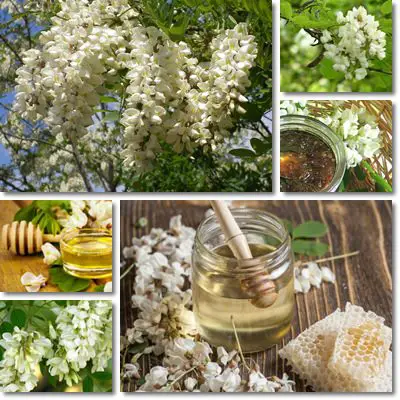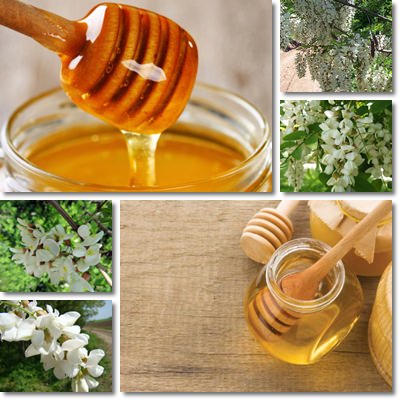Acacia honey is one the best types of honey. There are two things that make acacia honey better than all the others: the fact that it’s the least allergenic of all honey types and its ability to crystallize very slowly. Add its antimicrobial and antiseptic action, low pollen content, healing properties, energizing effect and antioxidant action and you have an incredible healthy natural product with a wonderful medicinal action. However, it is important to always choose certified brands to prevent getting a fake honey that has no real health benefits.
What is acacia honey made of?
Despite its name, acacia honey is made from the pollen of the flowers of the false acacia tree, also known as black locust (Robinia pseudoacacia). The tree is an invasive species in many parts of the world, but excellent at fixating soil and preventing erosion as well as an ideal solution for poor soils because it fixates nitrogen with the help of its roots, enriching soil for other plants. Black locust trees grow well in full sun.

What does black locust look like?
Robinia pseudoacacia trees have fern-like leaves, meaning they are compound leaves that grow in pairs along a thin green stem and end with one leaflet at the top of the stem. Young leaflets are a light, bright green, while mature leaflets are dark green, slightly paler underneath.
The tree and leaves are covered in thorns shaped like elongated triangles and can appear both on the bark and at the base of the leaf (before the leaflets begin). The species blossoms in May-June and produces gorgeous clusters of small, white (sometimes golden, pink or purple) flowers, very similar in appearance to bean flowers.
Clusters may be up to 25 cm long and flowers have a sweet floral smell to them. Because acacia trees are botanically legumes (think peas and beans), their fruit are seeds enclosed in pods similar to beans pods. It is from the pollen of false acacia flowers that acacia honey is made. Also, both the flowers and the ripe seeds are eaten in various parts of the world. While the seeds are shelled and boiled, the flowers are fried in batter and enjoyed as acacia doughnuts, a common delicacy in Romania.
What does acacia honey look like?
Acacia honey is a clear, pale yellow and has a thick, sticky, liquid consistency. However, moisture content, amount of rainfall, temperature, amount of flowers produce in a given year, specific beekeeping practices can lead to the honey having a slightly darker appearance.
What does acacia honey taste like?
The honey has a mildly sweet, slightly floral flavor that does not alter the taste of beverages it is added to. Find your favorite variety on our honey page.

Health benefits of Acacia Honey
What is acacia honey good for? The variety is good for soothing a sore throat in respiratory infections thanks to its natural antimicrobial properties, corrects low blood sugar and raises energy levels as well as can be used for skin care.
Here are the most impressive 7 properties and health benefits of acacia honey:
1) Antiseptic properties
Acacia honey and honey in general boasts strong natural antiseptic properties, inhibiting the growth of bacteria and other infectious agent. According to research, the honey contains hydrogen peroxide, a powerful natural disinfectant. Hydrogen peroxide is synthesized with the help of an enzyme from pollen called catalase and an enzyme produced by bees called glucose oxidase, which synthesize hydrogen peroxide from glucose. The amount of glucose in each honey variety accounts for the antimicrobial potency. Acacia honey has been found to have anywhere between 22 to 38 g of glucose per 100 g of honey.
Another reason why acacia honey is a natural antiseptic is because it is acidic, having a low pH of around 3.5. This low pH inhibits the growth of bacteria, hence the reason why eating honey helps treat respiratory infections in which there is considerable bacterial load in the throat and using it in sterile bandages encourages wound healing. Its low moisture content also contributes to its antiseptic properties.
Moreover, the variety has been found to contain other antimicrobial elements such as polyphenols with antibacterial activity. Acacia honey concentration (because honey is diluted), its hydrogen peroxide content and other factors may influence its antiseptic properties.
2) Antioxidant and anticancer potential
Raw, undiluted, unprocessed honey is one of the key ingredients in Father Zago’s anticancer remedy along with Aloe arborescens leaves from plants older than 4-5 years and distillate. It can be theorized the potent polyphenols (ex: gallic acid, flavonoids) in honey, acacia included, may partly be responsible for such effects.
While the diet has not received medical approval, research has shown that antioxidants in general hold inhibitory and anti-proliferative properties and it has been suggested their action can constitute a good prevention and possibly lower cancer risks.
3) Least allergenic honey variety
Acacia flowers have been shown to produce less pollen than other types of flowers that bees produce honey from. This causes acacia honey to have a low pollen content, hence the reason it is the least likely to cause allergic reactions. However, people with multiple pollen allergies are advised to avoid any source of pollen until they have a skin prick test to see which pollen they are actually allergic to.
Although the number of allergic reactions to acacia honey is considerably lower compared to the number of allergic reactions to other types of honey, it is still possible to be allergic to this particular type.
4) It crystallizes very slowly
Unlike other honey types, acacia honey crystallizes very slowly. This means we can keep our jar of honey for almost as long as it takes us to finish it, without having to worry the honey will become hard and unusable. This particular quality that makes acacia honey more desirable than other varieties is because the honey has a higher fructose content (higher than glucose). Keeping the product at room temperature and lidded should be enough to preserve it well.
5) Good for hypoglycemia
Acacia honey almost entirely simple carbohydrates, sugars. If I happen to skip a meal for some reason or delay eating so I can finish up on work and become hypoglycemic (it happens to me more often than I’d wish), I immediately eat a tablespoon or two of acacia honey to regain strength and not faint. The energy it provides me with gives me allows me to have time to eat something more substantial. I’d say a tablespoon gives me energy for about 15-25 minutes.

6) Healthy substitute for refined sugar and other sweeteners
If you must sweeten tea, fruity water, waffles, crepes or pancakes, then go for honey, acacia especially. It’s a natural source of sugars, sweet and fragrant, far more nutritious and healthier than plain sugar or artificial sweeteners. It actually contains antioxidants and special enzymes our body digests fairly easily compared to the other options.
Moreover, because of its high fructose content (around 45%), it is even recommended for type-2 diabetes sufferers. However, it is important to first talk to your doctor if you have diabetes and want to include acacia honey into your diet.
7) Energizing properties
Being all simple carbohydrates, acacia honey is a great energizing food, recommended for children or anyone recovering from illness, exhaustion or a stressful period. Not only does it give us physical energy, but studies suggest it may also help improve stress and depression symptoms ( Study). Its high antioxidant content is partly responsible for such health effects. Moreover, it can help improve appetite and exert tonic properties. Acacia honey does not help you lose weight.
What is Acacia Honey used for?
Common uses of acacia honey. The honey can be used as a sweetener, especially for herbal teas because its flavor does not alter the taste of the infusion. It can be consumed as such, one tablespoon on an empty stomach, 20 to 30 minutes before a meal. This is said to help calm inflammation and irritation of the stomach lining and help with other digestive conditions. Acacia honey is also said to support liver function.
Moreover, its strong antiseptic properties and low moisture but sticky consistency that allows it to adhere to mucous membranes makes it great for a sore throat, calming irritation, improving cough and reducing bacterial load in case of respiratory tract infections located in the throat. Acacia honey can make a great face mask, illuminating skin and making it soft and clear. Also, sterile bandages from unprocessed, organic, carefully handled honey are currently being developed to decrease wound healing time.
However, it is important to also keep in mind that honey in general is not cheap, acacia included. Being an organic, natural product, prices are and should be rather high. But if you do see honey that is cheap, then you should think twice before buying it. If experience has taught me something is that if the honey is almost as cheap as sugar, than maybe it’s really sugar. While healthy and accessible, acacia honey is the easiest to fake by using sugar, glucose, corn syrup, starch etc. So be weary of cheap honey that is not certified because if it’s just sugar, then you eat it for nothing because it doesn’t have any benefits.
Conclusion
Eating acacia honey on a regular basis is an extremely healthy habit, but only if the honey is high-quality, organic and unprocessed. Heat exposure, for example, can alter its properties, especially its antimicrobial effects, and make it less beneficial for us. This is why when we add it to our tea to sweeten it, we should wait at least until the tea is lukewarm so its heat does not impact the properties and benefits of the raw honey. Out of all varieties, I have to admit acacia honey is my favorite, especially since the flowers it comes from are not treated with pesticides and it has the gentlest flavor.
